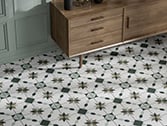Laminate Flooring
- Page 1: Laminate Flooring - Introduction
- Page 2: Laminate Flooring - Before you start
- Page 3: Laminate Flooring - Fitting twinclic
- Page 4: Laminate Flooring - Fitting 1clic2go
- Page 5: Laminate Flooring - Maintenance
- Page 6: Laminate Flooring - FAQs
- Back to Buying Guide
Laminate Flooring - Before you start
Ensure you always read through the fitting instructions found within the pack before starting. Precisely follow the instructions, in order to retain full warranty and guarantee claims. Please check the panels in good lighting conditions for defects. Once you have used the panels you can no longer make any claims due to defects.
An important prerequisite for the installation and long preservation of the laminate is a relative air humidity of 50-70%.
- The sub-floor must be absolutely level, dry, clean and firm.
- When laying on mineral surfaces e.g. concrete, cement screed, anhydrite screed and stone tiles, etc.. extra care must be taken.
- Please allow 1 week drying time per cm depth to allow to completely dry out. Fit a Damp Proof Membrane (DPM) between mineral subfloor and underlay/ laminate flooring.
- Laminate flooring is laid “floating” and must not be glued, nailed or fixed to the sub-floor in any other way (e.g. by means of door stoppers)
- We recommend you sort the panels before laying according to the required grain direction and any colour nuances.
- Use the contents of opened packages immediately. You will need the following to lay the flooring: Impact sound insulation, PE foil, spacing wedges, chock, fitting aid, saw, pencil and folding rule. If required, laminate floor joint sealant, White (PVA) glue D3, jointing compound.
Depending on the area of use, there are three laying possibilities open to you:
- Fast, glue-free laying.
- Laying with Laminate flooring joint sealant. Laminate flooring sealant permanently protects the floor from moisture effects acting from above. Laminate flooring sealant does not glue panels down or together.
- Laying with glue also provides lasting protection against moisture, however the work is more complicated and time consuming and the flooring cannot be dismantled for possible relaying.














